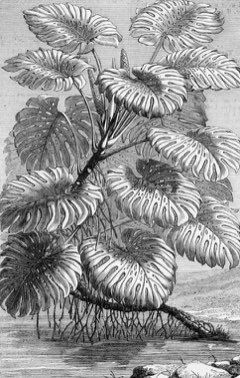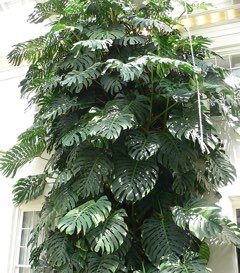 |
|
http://www.edibleplants.org |
 |
| wikimedia.org |
Translate this page:
Summary
Native to tropical rainforests of Mexico, Monstera deliciosa or Ceriman is a climbing, flowering shrub commonly grown as an ornamental indoor plant but has delicious, edible fruits. It grows about 20 m high, with aerial roots and large, leathery, glossy, and heart-shaped leaves. It can be propagated by air layering or internal cuttings. The aerial roots are used as ropes and in making baskets. Root infusion is used against arthritis. The whole plant can be toxic when consumed fresh because it contains calcium oxalate crystals which can easily be broken down by thoroughly cooking or fully drying the plant.
Physical Characteristics

 Monstera deliciosa is an evergreen Climber growing to 20 m (65ft) by 6 m (19ft) at a fast rate.
Monstera deliciosa is an evergreen Climber growing to 20 m (65ft) by 6 m (19ft) at a fast rate.
See above for USDA hardiness. It is hardy to UK zone 10. The flowers are pollinated by Bees, Insects.
Suitable for: light (sandy), medium (loamy) and heavy (clay) soils and prefers well-drained soil. Suitable pH: mildly acid and neutral soils and can grow in very acid soils.
It can grow in full shade (deep woodland) semi-shade (light woodland) or no shade. It prefers moist or wet soil.
UK Hardiness Map
US Hardiness Map
Synonyms
Monstera lennea K.Koch Monstera tacanaensis Matuda Philodendron anatomicum Kunth Tornelia fragrans G
Plant Habitats
Edible Uses
Edible Parts: Fruit
Edible Uses: Drink
Fruit - raw. The juicy, subacid fruits have an excellent aroma and taste, combining the flavours of bananas and pineapples[46 , 301 ]. The fruit is eaten raw, made into jellies and jams, and is also used in ice creams, sherbets, soft drinks etc[301 , 335 ]. Some people find the fruit unpleasant to eat because it can contain irritating crystals in the pulp[335 ]. The fruit is 8 - 12mm long, held in a bunch on a spadix that can be 25cm long[200 , 301 ]. The fruiting spadices become whitish at maturity and very juicy. They are sweet and of good flavour and often are eaten, but care must be taken to eat only fruits that are thoroughly ripe, since immature ones will cause swelling and irritation of the mouth because of needle-like crystals of calcium oxalate found in the tissues or sap[331 ].
References More on Edible Uses
Medicinal Uses
Plants For A Future can not take any responsibility for any adverse effects from the use of plants. Always seek advice from a professional before using a plant medicinally.
None known
References More on Medicinal Uses
The Bookshop: Edible Plant Books
Our Latest books on Perennial Plants For Food Forests and Permaculture Gardens in paperback or digital formats.

Edible Tropical Plants
Food Forest Plants for Hotter Conditions: 250+ Plants For Tropical Food Forests & Permaculture Gardens.
More

Edible Temperate Plants
Plants for Your Food Forest: 500 Plants for Temperate Food Forests & Permaculture Gardens.
More

More Books
PFAF have eight books available in paperback and digital formats. Browse the shop for more information.
Shop Now
Other Uses
Basketry Furniture Weaving
Other Uses The aerial roots of these plants, as well as those of some other aroids, particularly Philodendron, often attain a great length, reaching from the branches of fairly high trees almost or quite to the ground. They are much used in Guatemala for making the so-called mimbre furniture, similar to the light rattan furniture made commonly in the United States. The dried roots, of uniform diameter, or sometimes the fresh ones, are wound tightly and evenly about a wooden frame, forming handsome and durable articles of furniture[331 ]. The roots are also used to make strong baskets[331 ].
Special Uses
Food Forest
References More on Other Uses
Cultivation details
A plant of the hot, humid, tropical lowlands, though it can also be found at elevations up to 1,500 metres[331 , 335 ]. It grows best in areas where annual daytime temperatures are within the range 28 - 34°c, but can tolerate 18 - 38°c[418 ]. When dormant, the plant can survive temperatures down to about -3°c, but young growth can be severely damaged at -1°c[418 ]. It prefers a mean annual rainfall in the range 1,300 - 2,000mm, but tolerates 1,000 - 2,500mm[418 ]. Prefers growing in a shady position[302 ], but can tolerate a wide range from deep shade to fairly open and sunny[418 ]. Although it is often an epiphytic plant, it grows very well in the earth - often becoming a pest in fact because of their rapid growth and spread[331 ]. It prefers a fertile, moist, but well-drained soil[302 ]. Prefers a pH in the range 5.5 - 6, tolerating 5 - 7.5[418 ]. The plant forms two types of aerial roots from the nodes and internodes of the stems - one type grows down to the ground where it roots and is a source of moisture and nutrients, the other type is an anchor root, growing around the stem of the host plant[916 ]. Seedling plants can commence bearing fruit when 6 - 8 years old, plants from cuttings when 3 - 4 years old[335 ]. Plants can flower and produce fruit all year round[335 ]. Flowering Time: Mid Summer. Bloom Color: Cream/Tan. Spacing: 24-36 in. (60-90 cm).
References Carbon Farming Information and Carbon Sequestration Information
Temperature Converter
Type a value in the Celsius field to convert the value to Fahrenheit:
Fahrenheit:
The PFAF Bookshop
Plants For A Future have a number of books available in paperback and digital form. Book titles include Edible Plants, Edible Perennials, Edible Trees,Edible Shrubs, Woodland Gardening, and Temperate Food Forest Plants. Our new book is Food Forest Plants For Hotter Conditions (Tropical and Sub-Tropical).
Shop Now
Plant Propagation
Seed - must not be allowed to dry out[200 ]. Air layering. Internodal cuttings. Cuttings made from growing tips with one leaf attached.
Other Names
If available other names are mentioned here
Ceriman, Windowleaf, Split-leaf Philodendron, Mexican Breadfruit, Balaco, Balazos, Banana de macaco, Costila de Adan, Cut leafed Philodendron, Fensterblatt, Fruit Salad Plant, Gui bei zhu, Harpon, Mexican breadfruit, Monstera, Monsutera derishioosa, Pinanona monstera, Pinanona, Swiss-cheese plant,
Native Range
NORTHERN AMERICA: Mexico, Chiapas, Oaxaca, Veracruz de Ignacio de la Llave, SOUTHERN AMERICA: Costa Rica, Guatemala, Panama,
Weed Potential
Right plant wrong place. We are currently updating this section.
Please note that a plant may be invasive in one area but may not in your area so it's worth checking.
Conservation Status
IUCN Red List of Threatened Plants Status : This taxon has not yet been assessed

Growth: S = slow M = medium F = fast. Soil: L = light (sandy) M = medium H = heavy (clay). pH: A = acid N = neutral B = basic (alkaline). Shade: F = full shade S = semi-shade N = no shade. Moisture: D = dry M = Moist We = wet Wa = water.
Now available:
Food Forest Plants for Mediterranean Conditions
350+ Perennial Plants For Mediterranean and Drier Food Forests and Permaculture Gardens.
[Paperback and eBook]
This is the third in Plants For A Future's series of plant guides for food forests tailored to
specific climate zones. Following volumes on temperate and tropical ecosystems, this book focuses
on species suited to Mediterranean conditions—regions with hot, dry summers and cool, wet winters,
often facing the added challenge of climate change.
Read More
Expert comment
Author
Liebm.
Botanical References
Links / References
For a list of references used on this page please go here
A special thanks to Ken Fern for some of the information used on this page.
Readers comment
| Add a comment |
|
If you have important information about this plant that may help other users please add a comment or link below. Only comments or links that are felt to be directly relevant to a plant will be included. If you think a comment/link or information contained on this page is inaccurate or misleading we would welcome your feedback at [email protected]. If you have questions about a plant please use the Forum on this website as we do not have the resources to answer questions ourselves.
* Please note: the comments by website users are not necessarily those held by PFAF and may give misleading or inaccurate information.
To leave a comment please Register or login here All comments need to be approved so will not appear immediately.
|
Subject : Monstera deliciosa
|
|
|
|